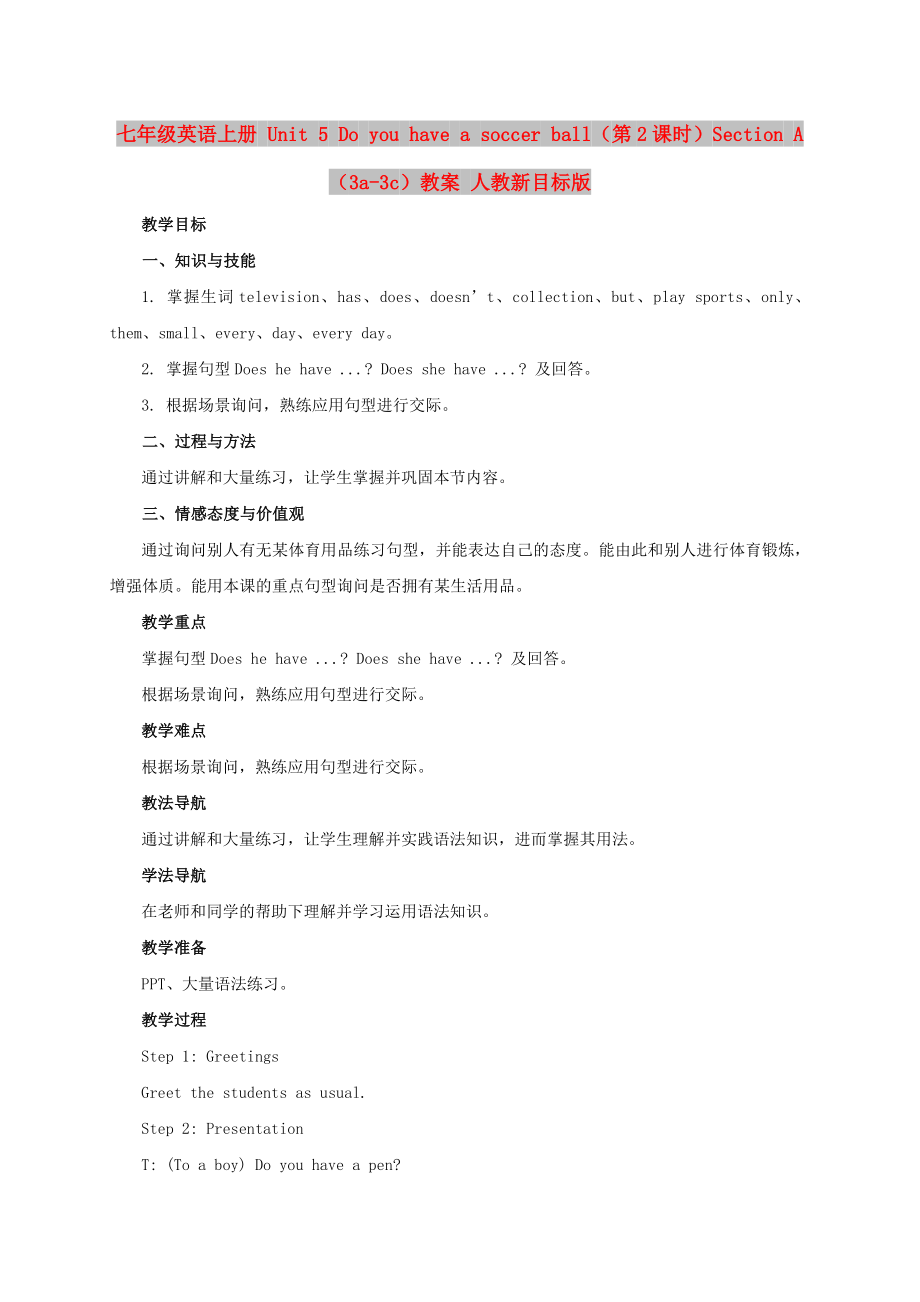《七年級(jí)英語上冊(cè) Unit 5 Do you have a soccer ball(第2課時(shí))Section A(3a-3c)教案 人教新目標(biāo)版》由會(huì)員分享��,可在線閱讀���,更多相關(guān)《七年級(jí)英語上冊(cè) Unit 5 Do you have a soccer ball(第2課時(shí))Section A(3a-3c)教案 人教新目標(biāo)版(4頁珍藏版)》請(qǐng)?jiān)谘b配圖網(wǎng)上搜索��。
1����、七年級(jí)英語上冊(cè) Unit 5 Do you have a soccer ball(第2課時(shí))Section A(3a-3c)教案 人教新目標(biāo)版
教學(xué)目標(biāo)
一���、知識(shí)與技能
1. 掌握生詞television、has�、does�、doesn’t�����、collection���、but����、play sports���、only��、them�����、small��、every���、day、every day��。
2. 掌握句型Does he have ...? Does she have ...? 及回答。
3. 根據(jù)場(chǎng)景詢問�����,熟練應(yīng)用句型進(jìn)行交際�����。
二�、過程與方法
通過講解和大量練習(xí),讓學(xué)生掌握并鞏固本節(jié)內(nèi)容�����。
三��、情感態(tài)
2�、度與價(jià)值觀
通過詢問別人有無某體育用品練習(xí)句型,并能表達(dá)自己的態(tài)度���。能由此和別人進(jìn)行體育鍛煉��,增強(qiáng)體質(zhì)。能用本課的重點(diǎn)句型詢問是否擁有某生活用品�。
教學(xué)重點(diǎn)
掌握句型Does he have ...? Does she have ...? 及回答�。
根據(jù)場(chǎng)景詢問���,熟練應(yīng)用句型進(jìn)行交際��。
教學(xué)難點(diǎn)
根據(jù)場(chǎng)景詢問��,熟練應(yīng)用句型進(jìn)行交際��。
教法導(dǎo)航
通過講解和大量練習(xí)���,讓學(xué)生理解并實(shí)踐語法知識(shí),進(jìn)而掌握其用法�。
學(xué)法導(dǎo)航
在老師和同學(xué)的幫助下理解并學(xué)習(xí)運(yùn)用語法知識(shí)。
教學(xué)準(zhǔn)備
PPT��、大量語法練習(xí)���。
教學(xué)過程
Step 1: Greetings
Greet the st
3���、udents as usual.
Step 2: Presentation
T: (To a boy) Do you have a pen?
S1: Yes, I do.
T: (To other students) Does he have a pen?
Ss: Yes, he does.
T: (To a girl) Do you have a knife?
S2: No, I don’t.
T: (To other students) Does she have a knife?
Ss: No, she doesn’t.
Get the students to ta
4、lk about the usage of “do” and “does”.
Then help the students to conclude the usage of them.
Step 3: Show a picture (some balls).
According to the form and make a dialogue with “Does he/she have ...? Yes, he/she does. No, he/she doesn’t.”
Jane
Mike
Barry
Peter
baseball
√
basketball
5����、
√
√
soccer ball
√
volleyball
√
Step 4: Make a survey
Write four questions with “Do you have ...?”
Find people in the class who has these things.
Write their names.
Then turn the sentences into “Does ... have ... ?”
Practice the sentences patterns “Do you have ...? Does
6����、 he/she have ...?”.
Step 5: Do the exercises
1. Do the exercises of 3a.
2. Give a student a kind of ball and ask: Do you have a baseball? (Yes, I have.) Great! I have a bat. Let’s play!
Get the students to practice the dialogue as much as possible.
Practice the other two dialogues in the same w
7�����、ay.
Step 6: Practice
Show the students the picture of Bob’s room. And then practice the dialogue: Does Bob have a soccer ball? Yes, he does.
Step 7: Look back (Grammar focus)
Let the students sum up what we have learned this class. Look at the grammar focus:
Do you have a TV?
Yes, I do./No, I
8�、don’t.
Do they have a puter?
Yes, they do./No, they don’t.
Does he have a tennis racket?
Yes, he does./No, he doesn’t.
Does she have a soccer ball?
Yes, she does./No, she doesn’t.
Does Chi-Young have a baseball?
Yes, he does./No, he doesn’t.
Emphasize the usage of “do” and “does”.
Then ask
9、 what they haven’t understood.
Step 8: Homework
1. Practice the dialogue as much as possible with your partner.
2. Go over the whole class.
課堂作業(yè)
1. 給單詞娃娃找家��。
I he they you we she it Eric
do
does
2. 用do��、does��、don’t���、doesn’t填空
(1)A: _____ you have a soccer ball?
B: Yes, I __
10�、____.
A: Great! Let’s play.
(2)A: ______ John have a basketball?
B: No, he ________.
A: _______ he have a ping-pong ball?
B: Yes, I think he ________.
參考答案:
1. do: I, they, you, we does: he�����,she���,it���,Eric
2. (1) Do, do (2) Does, doesn’t, Does, does.
教學(xué)反思
do和does的用法是重點(diǎn)語法之一��,幫助學(xué)生掌握其基本用法并通過大量練習(xí)來鞏固還不夠���,還要經(jīng)常引入其他常見用法���。但注意不要一次引入過多,學(xué)生不容易接受��。
 七年級(jí)英語上冊(cè) Unit 5 Do you have a soccer ball(第2課時(shí))Section A(3a-3c)教案 人教新目標(biāo)版
七年級(jí)英語上冊(cè) Unit 5 Do you have a soccer ball(第2課時(shí))Section A(3a-3c)教案 人教新目標(biāo)版

